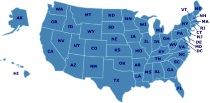Map & Globe Skills
The ability to properly read maps and globes gives you an opportunity to explore different places, people, and cultures in the real world. These resources, teaching tips, and ideas will help make it easy for your children to learn to read and understand maps and globes.
Activities & Experiments
Name That Country Game
"Dear Pen Pal, Konnichi wa! We've been to see Mt. Fuji. Name my country! Sayonara, Michiko." Challenge your group with this fast-paced geography game, created in 1992 by Educational Insights, Inc. Everyone begins at the post office. Players twirl a finely printed spinner (built into the game board itself) to select one of 60 countries. If the player can correctly identify the country's location on the board's numbered map, he or she may advance along the path to the finish. Bonus moves are won by landing on "postcard" spaces, listening to the clues on one of the 40 postcards, and correctly identifying the pen pal's country. (The sample postcard above came from Japan.) A more challenging game can be achieved by requiring players to name the country's capital; answers are provided. --Liane Thomas
Postcard Kids
Geography Postcard Kids Project started for homeschooled children around the world in October of 2002. It is intended to help enhance geographic studies by sending postcards from their local area to other postcard kids around the world.
Great States Board Game
What is the capital of NJ? Where is the Football Hall of Fame? These are just a few of the hundreds of questions players are asked as they adventure around the USA discovering state attractions and landmarks, capitals, state abbreviations, state locations and more. In order to answer the questions on the cards, players must look closely at the colorful USA map game board, becoming familiar with the geography of the country. Players must hurry to find the answers as the mechanical timer ticks. Contents: Game board, 100 Figure cards, 100 Fact cards, 100 Find cards, 1 spinner, 1 mechanical timer, and game rules. Duration of Play: 20 minutes. 2-6 players.
Teaching Tips & Ideas
Knowledge Quest
Knowledge Quest offers historical outline maps and timelines designed for the interactive study of world history and geography.
How I Teach a Large Family in a Relaxed, Classical Way: History
A look at teaching history across several grades using the classical method of education and a rotation of history every four years.
Featured Resources
As an Amazon Associate, we earn from qualifying purchases. We get commissions for purchases made through links on this site.
Dr. Montessori's Own Handbook
A short, illustrated guide to the use of Montessori classroom materials. Describes how to set up a "children's house" - an environment for learning where children can be their own masters.
Homeschoolers' Success Stories : 15 Adults and 12 Young People Share the Impact That Homeschooling Has Made on Their Lives
Despite their growing numbers, many homeschoolers still find their experience somewhat isolating. This collection of short biographies aims to alleviate some of that loneliness. While the stories profile modern-day homeschool grads and students, famous homeschooled personalities from the past are offered up early in the book for historical inspiration. John Adams, Abraham Lincoln, steel magnate Andrew Carnegie, newspaper publisher Joseph Pulitzer, photographer Ansel Adams, poet Robert Frost, and...
Please Don't Drink the Holy Water
Susie Lloyd faces the trials and joy of raising a happy, active Catholic family.
America's Spectacular National Parks
The concept of the national park is an American contribution to world civilization, and it remains a defining characteristic of our country. From the rocky shore of Maine's Acadia to the barren crater and lush rain forest of Hawaii's Haleakala, America's national beauty is celebrated and preserved in its national parks. This book retells the history of each park, describes its most important features and wildlife, and reproduces its gorgeous scenery in full-color photographs that will enthrall a...
Greenleaf Press
Greenleaf Press is a small family-owned and operated publisher and supplier of quality books for children. They are committed to "twaddle-free", living books, and approach teaching history to children using biography and chronology. You will find sections in the catalog covering each major historical period in order, with a variety of biographies, reference books, and historical fiction. For Israel, Egypt, Greece, Rome, the Middle Ages, and the Renaissance and Reformation there are Greenleaf Stu...






